Nursing Practice, Healthcare System, and Challenges in Australia
VerifiedAdded on 2022/09/07
|7
|1653
|21
Homework Assignment
AI Summary
This assignment addresses various aspects of nursing practice within the Australian healthcare system. It covers domains of practice, codes of conduct, and ethical guidelines. The paper examines the roles of enrolled and registered nurses, healthcare teams, and the impact of non-western medicine. It delves into the Australian healthcare system's funding, services, challenges, and key principles like primary health care and wellness. The assignment also explores chronic care models, challenges in healthcare, the health of migrants, and community promotional strategies. It includes factors affecting nurses, such as education and specialization, and discusses the roles of organizations like ANMAC and AHPRA. The paper highlights challenges in the Australian health care system, including technological costs and demographic changes, while also discussing strengths like Medicare and insurance companies.
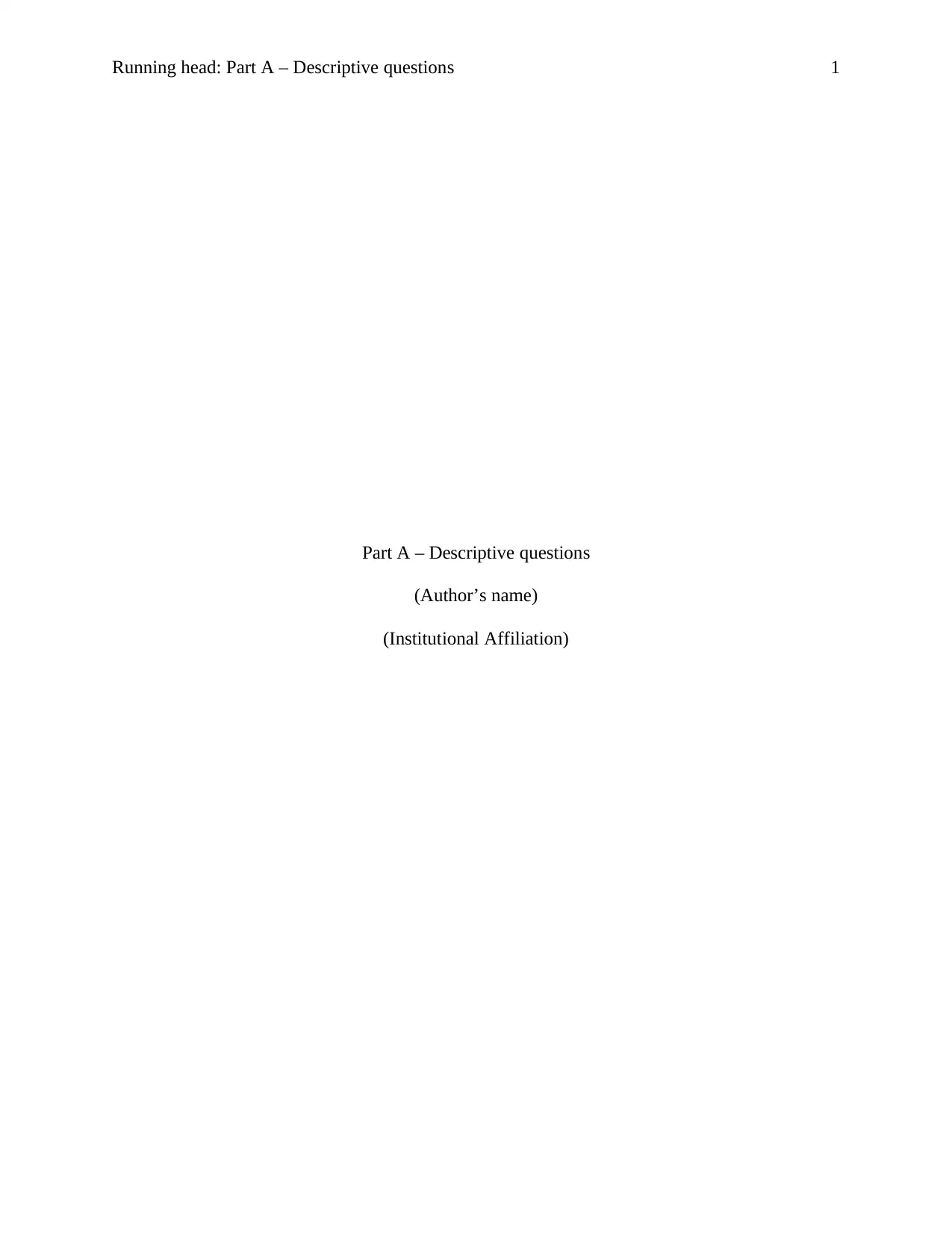
Running head: Part A – Descriptive questions 1
Part A – Descriptive questions
(Author’s name)
(Institutional Affiliation)
Part A – Descriptive questions
(Author’s name)
(Institutional Affiliation)
Paraphrase This Document
Need a fresh take? Get an instant paraphrase of this document with our AI Paraphraser
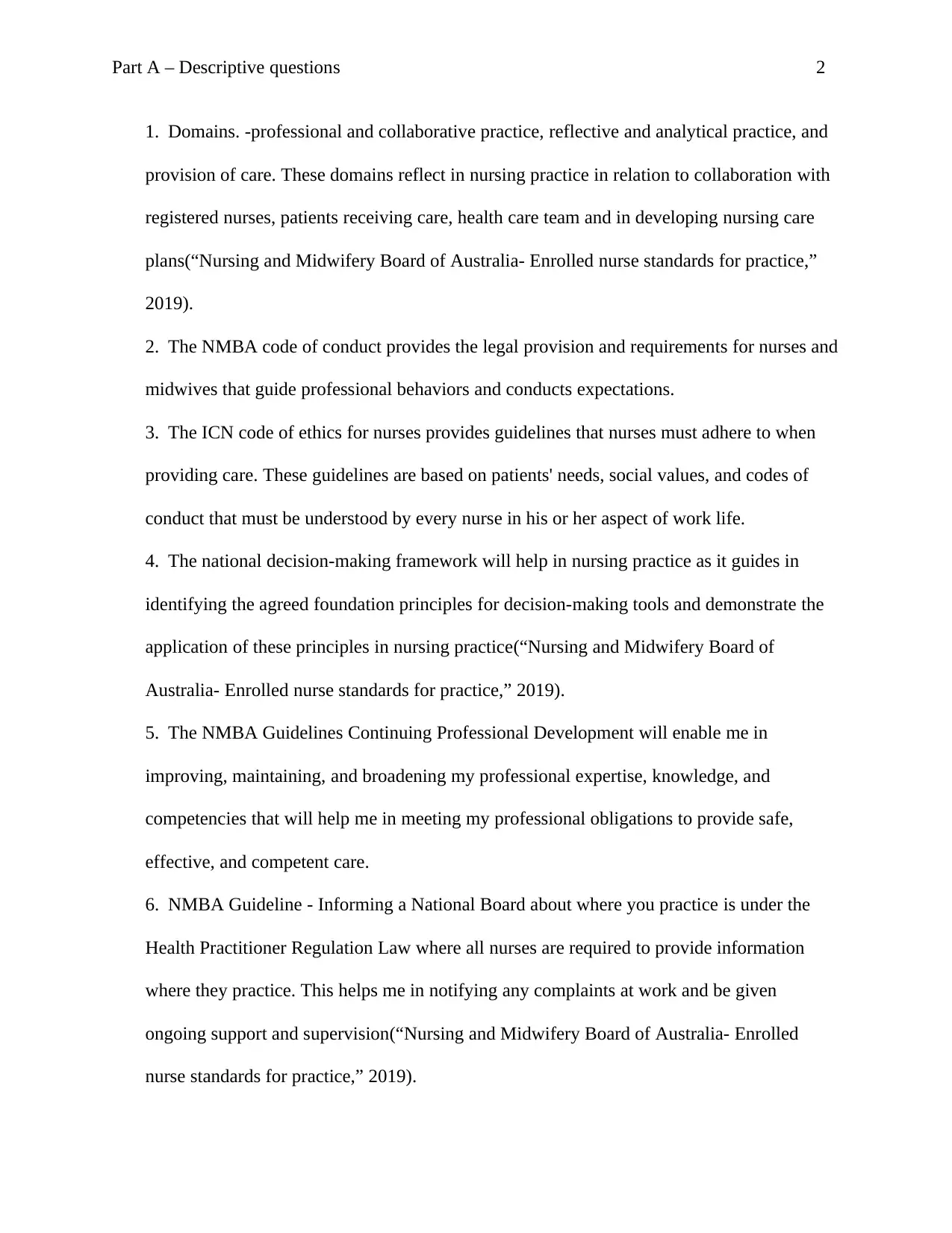
Part A – Descriptive questions 2
1. Domains. -professional and collaborative practice, reflective and analytical practice, and
provision of care. These domains reflect in nursing practice in relation to collaboration with
registered nurses, patients receiving care, health care team and in developing nursing care
plans(“Nursing and Midwifery Board of Australia- Enrolled nurse standards for practice,”
2019).
2. The NMBA code of conduct provides the legal provision and requirements for nurses and
midwives that guide professional behaviors and conducts expectations.
3. The ICN code of ethics for nurses provides guidelines that nurses must adhere to when
providing care. These guidelines are based on patients' needs, social values, and codes of
conduct that must be understood by every nurse in his or her aspect of work life.
4. The national decision-making framework will help in nursing practice as it guides in
identifying the agreed foundation principles for decision-making tools and demonstrate the
application of these principles in nursing practice(“Nursing and Midwifery Board of
Australia- Enrolled nurse standards for practice,” 2019).
5. The NMBA Guidelines Continuing Professional Development will enable me in
improving, maintaining, and broadening my professional expertise, knowledge, and
competencies that will help me in meeting my professional obligations to provide safe,
effective, and competent care.
6. NMBA Guideline - Informing a National Board about where you practice is under the
Health Practitioner Regulation Law where all nurses are required to provide information
where they practice. This helps me in notifying any complaints at work and be given
ongoing support and supervision(“Nursing and Midwifery Board of Australia- Enrolled
nurse standards for practice,” 2019).
1. Domains. -professional and collaborative practice, reflective and analytical practice, and
provision of care. These domains reflect in nursing practice in relation to collaboration with
registered nurses, patients receiving care, health care team and in developing nursing care
plans(“Nursing and Midwifery Board of Australia- Enrolled nurse standards for practice,”
2019).
2. The NMBA code of conduct provides the legal provision and requirements for nurses and
midwives that guide professional behaviors and conducts expectations.
3. The ICN code of ethics for nurses provides guidelines that nurses must adhere to when
providing care. These guidelines are based on patients' needs, social values, and codes of
conduct that must be understood by every nurse in his or her aspect of work life.
4. The national decision-making framework will help in nursing practice as it guides in
identifying the agreed foundation principles for decision-making tools and demonstrate the
application of these principles in nursing practice(“Nursing and Midwifery Board of
Australia- Enrolled nurse standards for practice,” 2019).
5. The NMBA Guidelines Continuing Professional Development will enable me in
improving, maintaining, and broadening my professional expertise, knowledge, and
competencies that will help me in meeting my professional obligations to provide safe,
effective, and competent care.
6. NMBA Guideline - Informing a National Board about where you practice is under the
Health Practitioner Regulation Law where all nurses are required to provide information
where they practice. This helps me in notifying any complaints at work and be given
ongoing support and supervision(“Nursing and Midwifery Board of Australia- Enrolled
nurse standards for practice,” 2019).
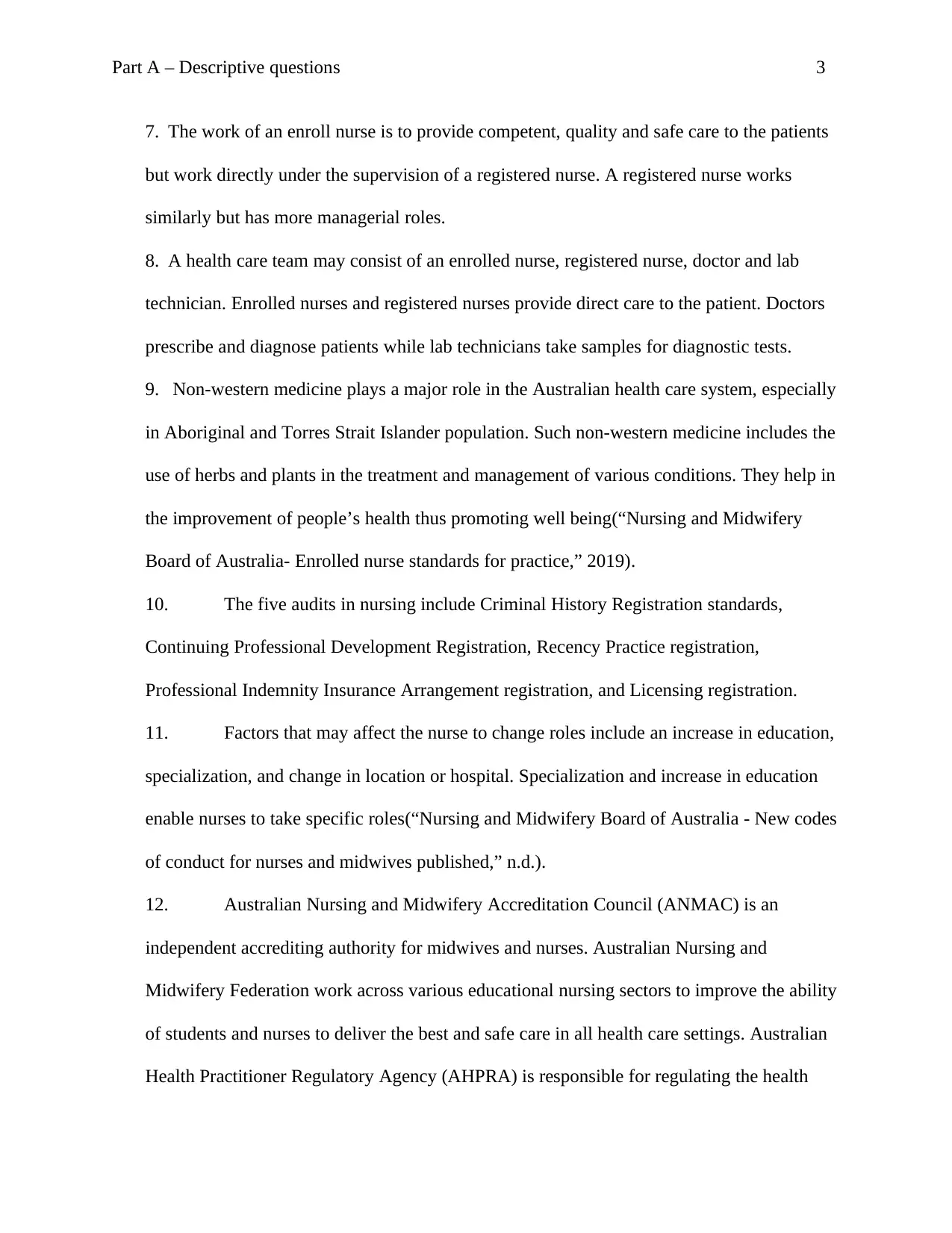
Part A – Descriptive questions 3
7. The work of an enroll nurse is to provide competent, quality and safe care to the patients
but work directly under the supervision of a registered nurse. A registered nurse works
similarly but has more managerial roles.
8. A health care team may consist of an enrolled nurse, registered nurse, doctor and lab
technician. Enrolled nurses and registered nurses provide direct care to the patient. Doctors
prescribe and diagnose patients while lab technicians take samples for diagnostic tests.
9. Non-western medicine plays a major role in the Australian health care system, especially
in Aboriginal and Torres Strait Islander population. Such non-western medicine includes the
use of herbs and plants in the treatment and management of various conditions. They help in
the improvement of people’s health thus promoting well being(“Nursing and Midwifery
Board of Australia- Enrolled nurse standards for practice,” 2019).
10. The five audits in nursing include Criminal History Registration standards,
Continuing Professional Development Registration, Recency Practice registration,
Professional Indemnity Insurance Arrangement registration, and Licensing registration.
11. Factors that may affect the nurse to change roles include an increase in education,
specialization, and change in location or hospital. Specialization and increase in education
enable nurses to take specific roles(“Nursing and Midwifery Board of Australia - New codes
of conduct for nurses and midwives published,” n.d.).
12. Australian Nursing and Midwifery Accreditation Council (ANMAC) is an
independent accrediting authority for midwives and nurses. Australian Nursing and
Midwifery Federation work across various educational nursing sectors to improve the ability
of students and nurses to deliver the best and safe care in all health care settings. Australian
Health Practitioner Regulatory Agency (AHPRA) is responsible for regulating the health
7. The work of an enroll nurse is to provide competent, quality and safe care to the patients
but work directly under the supervision of a registered nurse. A registered nurse works
similarly but has more managerial roles.
8. A health care team may consist of an enrolled nurse, registered nurse, doctor and lab
technician. Enrolled nurses and registered nurses provide direct care to the patient. Doctors
prescribe and diagnose patients while lab technicians take samples for diagnostic tests.
9. Non-western medicine plays a major role in the Australian health care system, especially
in Aboriginal and Torres Strait Islander population. Such non-western medicine includes the
use of herbs and plants in the treatment and management of various conditions. They help in
the improvement of people’s health thus promoting well being(“Nursing and Midwifery
Board of Australia- Enrolled nurse standards for practice,” 2019).
10. The five audits in nursing include Criminal History Registration standards,
Continuing Professional Development Registration, Recency Practice registration,
Professional Indemnity Insurance Arrangement registration, and Licensing registration.
11. Factors that may affect the nurse to change roles include an increase in education,
specialization, and change in location or hospital. Specialization and increase in education
enable nurses to take specific roles(“Nursing and Midwifery Board of Australia - New codes
of conduct for nurses and midwives published,” n.d.).
12. Australian Nursing and Midwifery Accreditation Council (ANMAC) is an
independent accrediting authority for midwives and nurses. Australian Nursing and
Midwifery Federation work across various educational nursing sectors to improve the ability
of students and nurses to deliver the best and safe care in all health care settings. Australian
Health Practitioner Regulatory Agency (AHPRA) is responsible for regulating the health
⊘ This is a preview!⊘
Do you want full access?
Subscribe today to unlock all pages.

Trusted by 1+ million students worldwide
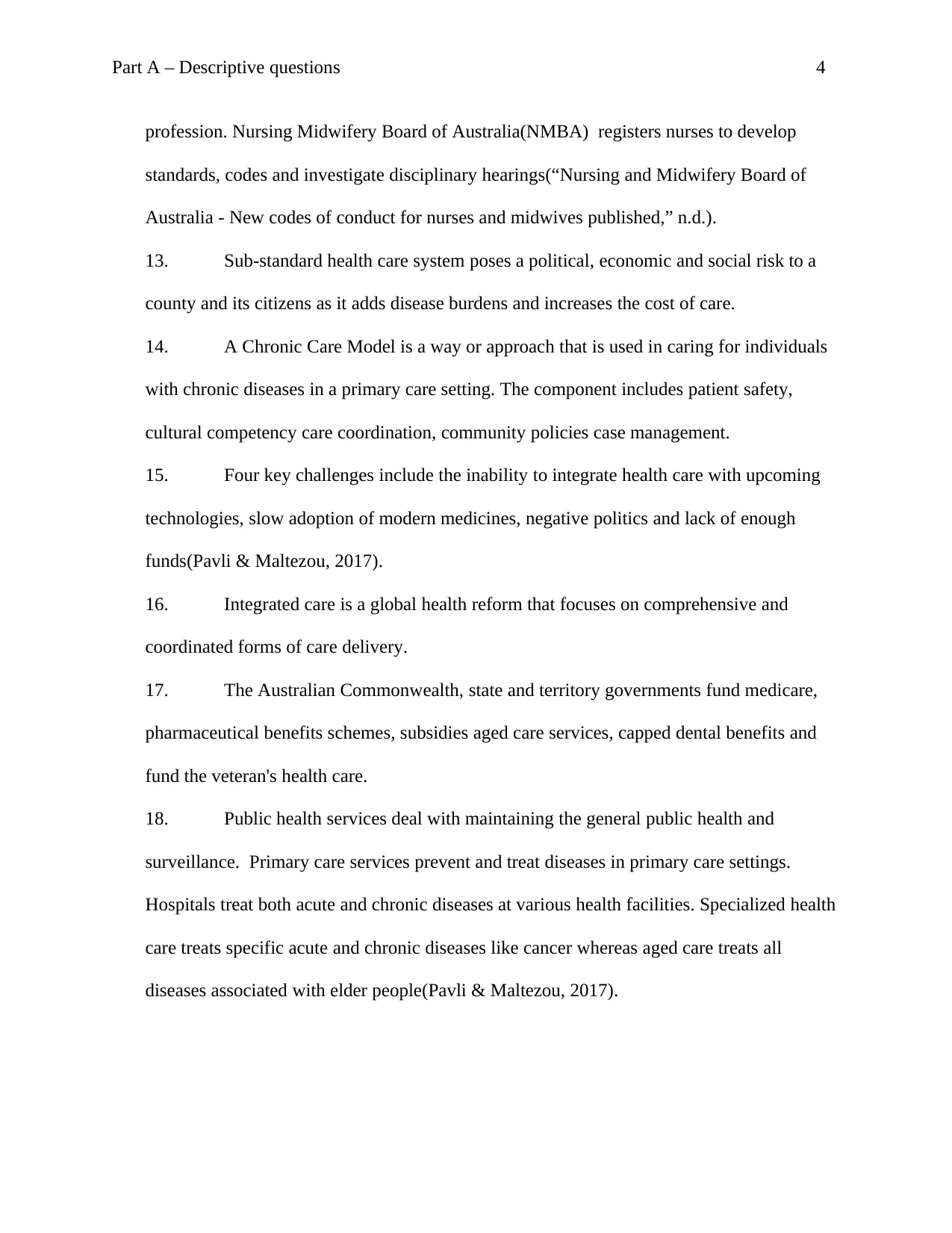
Part A – Descriptive questions 4
profession. Nursing Midwifery Board of Australia(NMBA) registers nurses to develop
standards, codes and investigate disciplinary hearings(“Nursing and Midwifery Board of
Australia - New codes of conduct for nurses and midwives published,” n.d.).
13. Sub-standard health care system poses a political, economic and social risk to a
county and its citizens as it adds disease burdens and increases the cost of care.
14. A Chronic Care Model is a way or approach that is used in caring for individuals
with chronic diseases in a primary care setting. The component includes patient safety,
cultural competency care coordination, community policies case management.
15. Four key challenges include the inability to integrate health care with upcoming
technologies, slow adoption of modern medicines, negative politics and lack of enough
funds(Pavli & Maltezou, 2017).
16. Integrated care is a global health reform that focuses on comprehensive and
coordinated forms of care delivery.
17. The Australian Commonwealth, state and territory governments fund medicare,
pharmaceutical benefits schemes, subsidies aged care services, capped dental benefits and
fund the veteran's health care.
18. Public health services deal with maintaining the general public health and
surveillance. Primary care services prevent and treat diseases in primary care settings.
Hospitals treat both acute and chronic diseases at various health facilities. Specialized health
care treats specific acute and chronic diseases like cancer whereas aged care treats all
diseases associated with elder people(Pavli & Maltezou, 2017).
profession. Nursing Midwifery Board of Australia(NMBA) registers nurses to develop
standards, codes and investigate disciplinary hearings(“Nursing and Midwifery Board of
Australia - New codes of conduct for nurses and midwives published,” n.d.).
13. Sub-standard health care system poses a political, economic and social risk to a
county and its citizens as it adds disease burdens and increases the cost of care.
14. A Chronic Care Model is a way or approach that is used in caring for individuals
with chronic diseases in a primary care setting. The component includes patient safety,
cultural competency care coordination, community policies case management.
15. Four key challenges include the inability to integrate health care with upcoming
technologies, slow adoption of modern medicines, negative politics and lack of enough
funds(Pavli & Maltezou, 2017).
16. Integrated care is a global health reform that focuses on comprehensive and
coordinated forms of care delivery.
17. The Australian Commonwealth, state and territory governments fund medicare,
pharmaceutical benefits schemes, subsidies aged care services, capped dental benefits and
fund the veteran's health care.
18. Public health services deal with maintaining the general public health and
surveillance. Primary care services prevent and treat diseases in primary care settings.
Hospitals treat both acute and chronic diseases at various health facilities. Specialized health
care treats specific acute and chronic diseases like cancer whereas aged care treats all
diseases associated with elder people(Pavli & Maltezou, 2017).
Paraphrase This Document
Need a fresh take? Get an instant paraphrase of this document with our AI Paraphraser
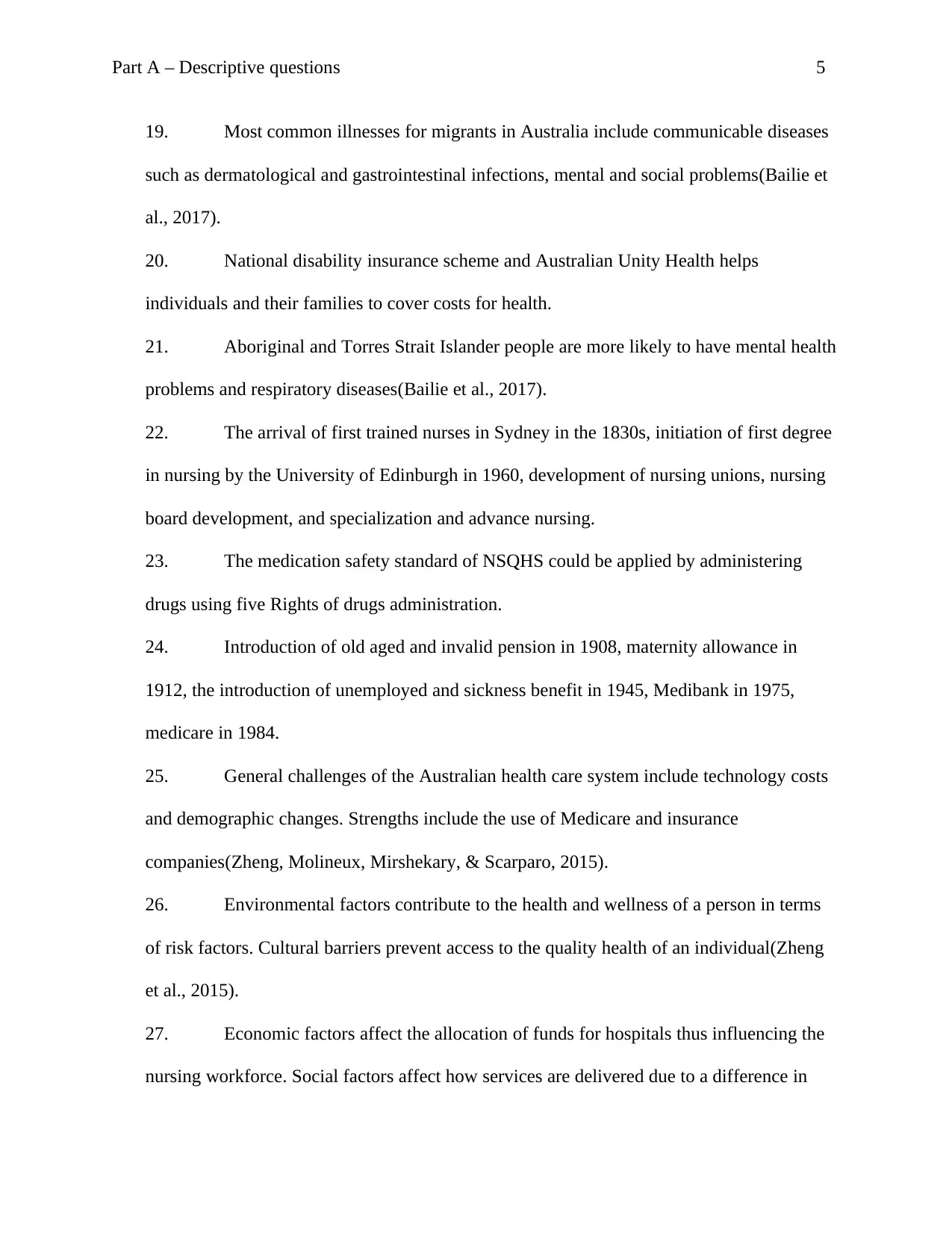
Part A – Descriptive questions 5
19. Most common illnesses for migrants in Australia include communicable diseases
such as dermatological and gastrointestinal infections, mental and social problems(Bailie et
al., 2017).
20. National disability insurance scheme and Australian Unity Health helps
individuals and their families to cover costs for health.
21. Aboriginal and Torres Strait Islander people are more likely to have mental health
problems and respiratory diseases(Bailie et al., 2017).
22. The arrival of first trained nurses in Sydney in the 1830s, initiation of first degree
in nursing by the University of Edinburgh in 1960, development of nursing unions, nursing
board development, and specialization and advance nursing.
23. The medication safety standard of NSQHS could be applied by administering
drugs using five Rights of drugs administration.
24. Introduction of old aged and invalid pension in 1908, maternity allowance in
1912, the introduction of unemployed and sickness benefit in 1945, Medibank in 1975,
medicare in 1984.
25. General challenges of the Australian health care system include technology costs
and demographic changes. Strengths include the use of Medicare and insurance
companies(Zheng, Molineux, Mirshekary, & Scarparo, 2015).
26. Environmental factors contribute to the health and wellness of a person in terms
of risk factors. Cultural barriers prevent access to the quality health of an individual(Zheng
et al., 2015).
27. Economic factors affect the allocation of funds for hospitals thus influencing the
nursing workforce. Social factors affect how services are delivered due to a difference in
19. Most common illnesses for migrants in Australia include communicable diseases
such as dermatological and gastrointestinal infections, mental and social problems(Bailie et
al., 2017).
20. National disability insurance scheme and Australian Unity Health helps
individuals and their families to cover costs for health.
21. Aboriginal and Torres Strait Islander people are more likely to have mental health
problems and respiratory diseases(Bailie et al., 2017).
22. The arrival of first trained nurses in Sydney in the 1830s, initiation of first degree
in nursing by the University of Edinburgh in 1960, development of nursing unions, nursing
board development, and specialization and advance nursing.
23. The medication safety standard of NSQHS could be applied by administering
drugs using five Rights of drugs administration.
24. Introduction of old aged and invalid pension in 1908, maternity allowance in
1912, the introduction of unemployed and sickness benefit in 1945, Medibank in 1975,
medicare in 1984.
25. General challenges of the Australian health care system include technology costs
and demographic changes. Strengths include the use of Medicare and insurance
companies(Zheng, Molineux, Mirshekary, & Scarparo, 2015).
26. Environmental factors contribute to the health and wellness of a person in terms
of risk factors. Cultural barriers prevent access to the quality health of an individual(Zheng
et al., 2015).
27. Economic factors affect the allocation of funds for hospitals thus influencing the
nursing workforce. Social factors affect how services are delivered due to a difference in
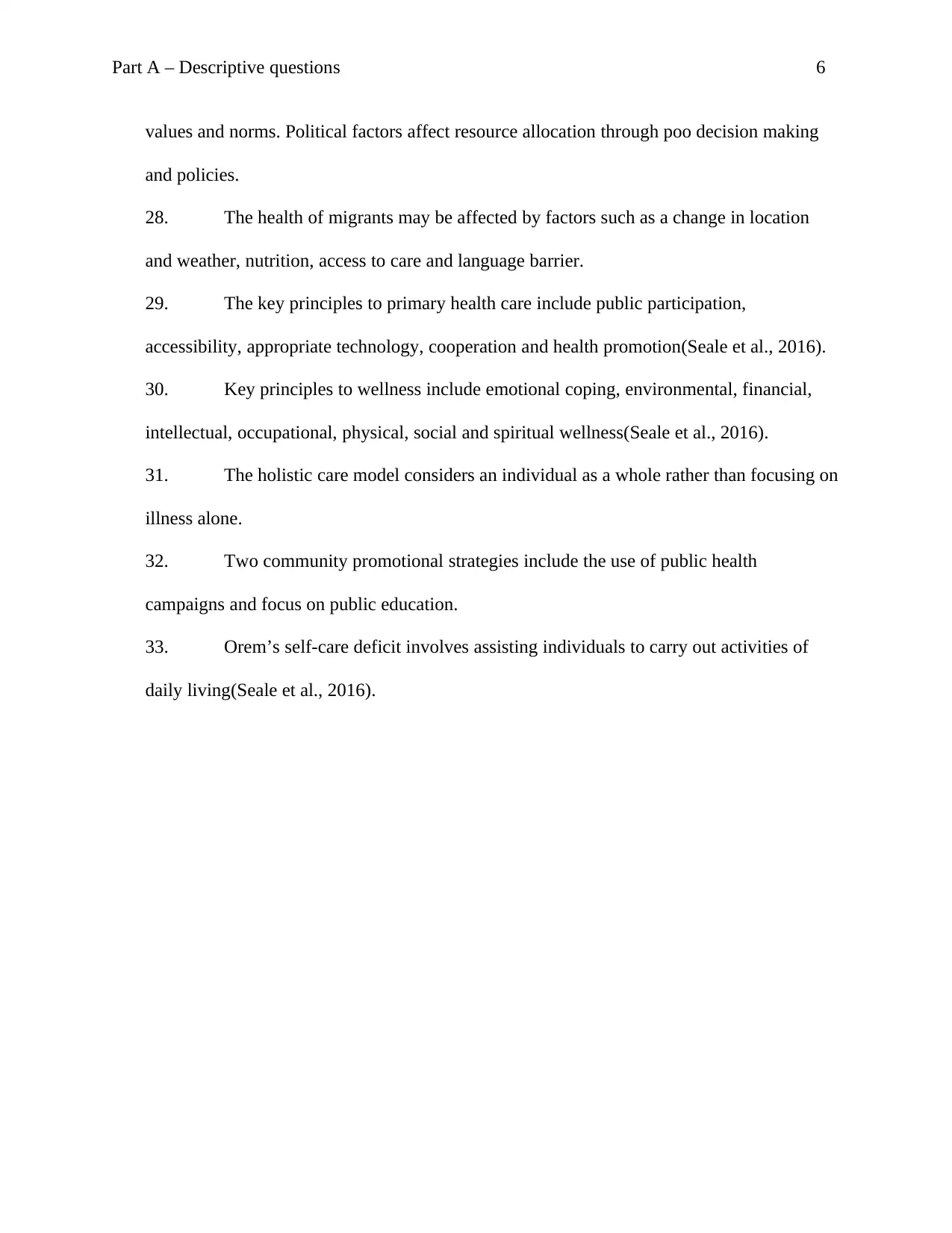
Part A – Descriptive questions 6
values and norms. Political factors affect resource allocation through poo decision making
and policies.
28. The health of migrants may be affected by factors such as a change in location
and weather, nutrition, access to care and language barrier.
29. The key principles to primary health care include public participation,
accessibility, appropriate technology, cooperation and health promotion(Seale et al., 2016).
30. Key principles to wellness include emotional coping, environmental, financial,
intellectual, occupational, physical, social and spiritual wellness(Seale et al., 2016).
31. The holistic care model considers an individual as a whole rather than focusing on
illness alone.
32. Two community promotional strategies include the use of public health
campaigns and focus on public education.
33. Orem’s self-care deficit involves assisting individuals to carry out activities of
daily living(Seale et al., 2016).
values and norms. Political factors affect resource allocation through poo decision making
and policies.
28. The health of migrants may be affected by factors such as a change in location
and weather, nutrition, access to care and language barrier.
29. The key principles to primary health care include public participation,
accessibility, appropriate technology, cooperation and health promotion(Seale et al., 2016).
30. Key principles to wellness include emotional coping, environmental, financial,
intellectual, occupational, physical, social and spiritual wellness(Seale et al., 2016).
31. The holistic care model considers an individual as a whole rather than focusing on
illness alone.
32. Two community promotional strategies include the use of public health
campaigns and focus on public education.
33. Orem’s self-care deficit involves assisting individuals to carry out activities of
daily living(Seale et al., 2016).
⊘ This is a preview!⊘
Do you want full access?
Subscribe today to unlock all pages.

Trusted by 1+ million students worldwide
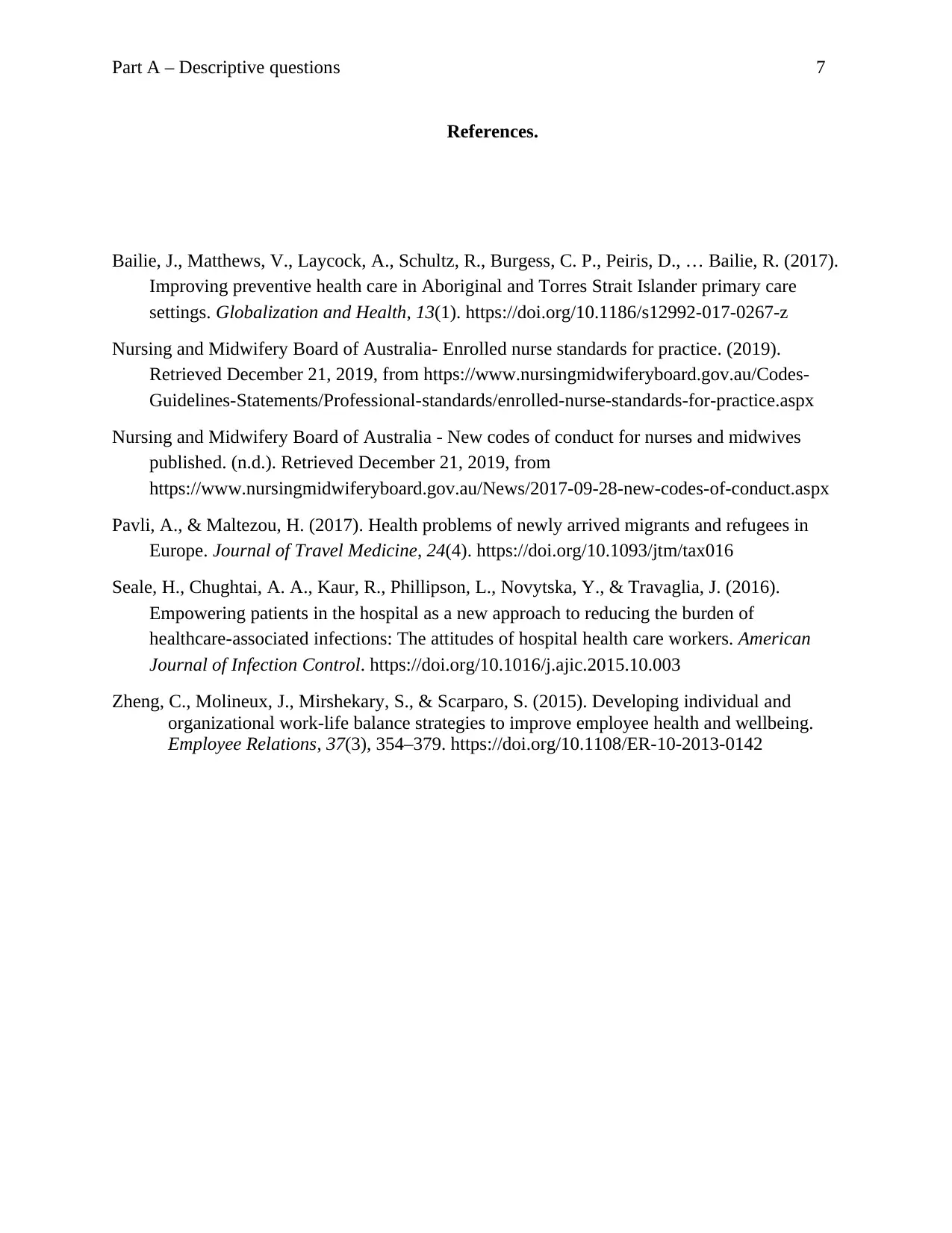
Part A – Descriptive questions 7
References.
Bailie, J., Matthews, V., Laycock, A., Schultz, R., Burgess, C. P., Peiris, D., … Bailie, R. (2017).
Improving preventive health care in Aboriginal and Torres Strait Islander primary care
settings. Globalization and Health, 13(1). https://doi.org/10.1186/s12992-017-0267-z
Nursing and Midwifery Board of Australia- Enrolled nurse standards for practice. (2019).
Retrieved December 21, 2019, from https://www.nursingmidwiferyboard.gov.au/Codes-
Guidelines-Statements/Professional-standards/enrolled-nurse-standards-for-practice.aspx
Nursing and Midwifery Board of Australia - New codes of conduct for nurses and midwives
published. (n.d.). Retrieved December 21, 2019, from
https://www.nursingmidwiferyboard.gov.au/News/2017-09-28-new-codes-of-conduct.aspx
Pavli, A., & Maltezou, H. (2017). Health problems of newly arrived migrants and refugees in
Europe. Journal of Travel Medicine, 24(4). https://doi.org/10.1093/jtm/tax016
Seale, H., Chughtai, A. A., Kaur, R., Phillipson, L., Novytska, Y., & Travaglia, J. (2016).
Empowering patients in the hospital as a new approach to reducing the burden of
healthcare-associated infections: The attitudes of hospital health care workers. American
Journal of Infection Control. https://doi.org/10.1016/j.ajic.2015.10.003
Zheng, C., Molineux, J., Mirshekary, S., & Scarparo, S. (2015). Developing individual and
organizational work-life balance strategies to improve employee health and wellbeing.
Employee Relations, 37(3), 354–379. https://doi.org/10.1108/ER-10-2013-0142
References.
Bailie, J., Matthews, V., Laycock, A., Schultz, R., Burgess, C. P., Peiris, D., … Bailie, R. (2017).
Improving preventive health care in Aboriginal and Torres Strait Islander primary care
settings. Globalization and Health, 13(1). https://doi.org/10.1186/s12992-017-0267-z
Nursing and Midwifery Board of Australia- Enrolled nurse standards for practice. (2019).
Retrieved December 21, 2019, from https://www.nursingmidwiferyboard.gov.au/Codes-
Guidelines-Statements/Professional-standards/enrolled-nurse-standards-for-practice.aspx
Nursing and Midwifery Board of Australia - New codes of conduct for nurses and midwives
published. (n.d.). Retrieved December 21, 2019, from
https://www.nursingmidwiferyboard.gov.au/News/2017-09-28-new-codes-of-conduct.aspx
Pavli, A., & Maltezou, H. (2017). Health problems of newly arrived migrants and refugees in
Europe. Journal of Travel Medicine, 24(4). https://doi.org/10.1093/jtm/tax016
Seale, H., Chughtai, A. A., Kaur, R., Phillipson, L., Novytska, Y., & Travaglia, J. (2016).
Empowering patients in the hospital as a new approach to reducing the burden of
healthcare-associated infections: The attitudes of hospital health care workers. American
Journal of Infection Control. https://doi.org/10.1016/j.ajic.2015.10.003
Zheng, C., Molineux, J., Mirshekary, S., & Scarparo, S. (2015). Developing individual and
organizational work-life balance strategies to improve employee health and wellbeing.
Employee Relations, 37(3), 354–379. https://doi.org/10.1108/ER-10-2013-0142
1 out of 7
Related Documents
Your All-in-One AI-Powered Toolkit for Academic Success.
+13062052269
info@desklib.com
Available 24*7 on WhatsApp / Email
![[object Object]](/_next/static/media/star-bottom.7253800d.svg)
Unlock your academic potential
Copyright © 2020–2025 A2Z Services. All Rights Reserved. Developed and managed by ZUCOL.





